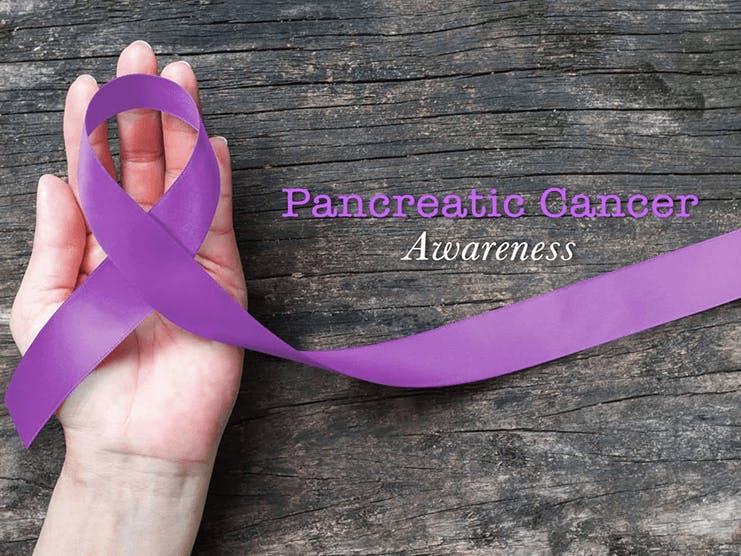
Medicare covers a variety of cancer treatments, including chemotherapy and radiation therapy.
Nestled near the stomach, liver, and large intestine, the pancreas is part of your digestive system. The organ is around 6 inches long and is responsible for helping your body digest food and process sugar. Cancer of the pancreas is relatively rare. However, due to the fact that there are few warning signs, it is one of the more deadly forms of the disease. In this post, we answer the question, Does Medicare cover pancreatic cancer screenings and treatment?
How does Medicare cover cancer treatment?
Generally speaking, Medicare covers cancer treatments that are deemed medically necessary by your physician. According to the Centers for Medicare & Medicaid Services (CMS), this may include healthcare services, prescription medications, and supplies intended to treat cancer.
Pancreatic cancer treatment covered by Medicare Part A
Medicare Part A covers inpatient services received in a hospital, including pancreatic cancer treatments. Other services covered by Part A include:
- Skilled nursing facility (SNF) care, assuming it follows a qualifying 3-day hospital stay
- Home health care services such as physical therapy, skilled nursing care, and occupational therapy
- Hospice care
- A portion of costs related to clinical research studies performed during your inpatient hospital stay
For Part A to apply, you must be admitted to the hospital. Until you're formally admitted, you are in what's known as observation status. That means Medicare Part B applies, not Part A. Your costs under Part B may be much higher than they would under Part A. Ask a hospital staff member to verify your status. If you're being kept under observation, ask your doctor to have you admitted.
Pancreatic cancer treatment covered by Medicare Part B
Medicare Part B covers outpatient medical services. As regards pancreatic cancer, this may include:
- Doctor visits with your oncologist and/or primary care provider
- Chemotherapy drugs administered intravenously as an outpatient
- Some chemotherapy treatments administered orally (ask your provider for details)
- Radiation treatment received as an outpatient
- Diagnostic tests used to screen and diagnose pancreatic cancer, such as CT scans and x-rays
- Durable medical equipment (DME), including equipment like a feeding pump you use in your home
- Outpatient surgical procedures, such as tumor removal
- Outpatient mental health services
- Nutritional counseling for patients who have either diabetes or kidney disease
Medicare Part B may also cover getting a second opinion on non-emergency surgeries. In the event the first two doctors disagree, Part B also covers a third opinion.
Cancer care not covered by Medicare
Medicare doesn't cover everything. Some common cancer care items not covered by Medicare include:
- Staying in an assisted living facility (room and board)
- Adult daycare
- Long-term nursing home care
- Supplements and medical food not administered by enteral nutrition equipment (i.e. feeding pump)
- Assistance with the "activities of daily living," such as eating, bathing, and getting into or out of bed
What you pay for pancreatic cancer treatment under Original Medicare
Original Medicare (Parts A and B) provides basic guidelines regarding your out-of-pocket costs.
- The Part A deductible is $1,632 per benefit period, which begins the day you're admitted to the hospital and ends once 60 days pass without inpatient treatment.
- Part A coinsurance is $0 per day for the first 60 days of each benefit period. After that, you pay $408 per day up to 90 days and $816 per day until you reach your 60 lifetime reserve days.
- Part B coinsurance is usually 20% of the Medicare-approved amount, assuming you've met the yearly deductible ($240 in 2024).
All costs assume your provider accepts assignment. Costs may vary, though, so ask your provider for specifics.
Medicare Part D coverage for pancreatic cancer
Medicare beneficiaries can get prescription drug coverage with a Part D plan. They may also choose a Medicare Advantage (MA) plan that covers prescription medications, known as an MA-PD plan.
Your Part D plan may cover cancer drug therapies not covered by Medicare Part B. Check your insurance company's drug formulary (list of covered prescription medications) to be sure. Common cancer drugs covered by Part D may include:
- Oral chemotherapy drugs
- Anti-nausea medications
- Pain medications
Our Find a Plan tool helps you compare Medicare plan options in your area, including Part D, Medigap, and Medicare Advantage plans. It's easy to use and completely free with no obligation. Just enter your location information to review Medicare plans in your area.
Medicare Part C coverage for pancreatic cancer
More commonly known as Medicare Advantage, Part C plans provide the same coverage you get with Original Medicare. However, many MA plans offer additional benefits, such as coverage for prescription drugs, routine vision and dental care, and hearing aids.
Benefits vary widely according to the plan and provider you choose. Call your plan for details regarding cancer treatment options.
Does Medigap cover pancreatic cancer?
Commonly known as Medigap, Medicare Supplement Insurance plans help pay some of your out-of-pocket costs under Original Medicare. Which costs your plan pays depends on which plan you choose. However, all Medigap plans cover your Part A coinsurance and give you an additional 365 lifetime reserve days. All Medicare Supplement plans also cover at least half of your Part B coinsurance.
You cannot combine a Medigap policy with a Medicare Advantage plan. Nor can you use your Supplement plan to pay for prescription drug costs.
How is pancreatic cancer diagnosed?
When you visit your doctor, he or she will ask about your symptoms. In particular, your doctor will want to know what they are and when they began. Your doctor should also ask about your risk factors, particularly whether you smoke, have a family history of pancreatic cancer, or a personal history of pancreatitis.
The physical exam will likely focus on the abdominal area. Your doctor is feeling for signs of a swollen liver or gallbladder. In addition, he or she will check your skin and eyes for signs of jaundice. Expect to answer questions about your bowel movements and urine as well.
If the physical exam and medical history questions do not rule out cancer, your doctor will likely order blood work. You should also expect a referral to a gastroenterologist and possibly further diagnostic tests. Typically, this means a CT scan, MRI, or ultrasound of the abdominal area. However, it may mean a more invasive screening called an endoscopic retrograde cholangiopancreatography, or ERCP.
What is an ERCP?
An ERCP involves inserting an endoscope down the esophagus and into the stomach and duodenum of the small intestine. The endoscope is a lighted, flexible tube that allows the doctor to inject a dye that helps highlight the organs of your digestive system so they can be viewed on an x-ray.
Your doctor may suggest an ERCP to determine the cause of your symptoms, particularly abdominal pain and jaundice. The test helps find tumors, blockages in the pancreatic or bile ducts, infection, and more.
Pancreatic cancer symptoms
Early detection of any cancer is vital toward fighting it successfully. Unfortunately, pancreatic cancer doesn't have many early warning signs beyond unintended weight loss, which is common for most cancers. If you've lost weight without trying to, talk to your doctor to find out why.
In addition to weight loss, the most common pancreatic cancer symptoms include:
- Back and/or belly pain: If the tumor presses against or spreads to other organs, it may cause pain the abdominal area.
- Decreased appetite: Many cancer patients have reduced appetite, which is one reason they may experience unintended weight loss.
- Deep vein thrombosis: This is a blood clot in the large vein in your leg.
- Enlarged liver or gallbladder: A tumor may block the bile duct, which in turn may cause the gallbladder or liver to become enlarged.
- Jaundice: Caused by a buildup of bilirubin in your liver, jaundice typically causes the whites of your eyes and/or your skin to take on a yellow tinge. Jaundice symptoms also include itchy skin, dark urine, and light-colored or greasy stools.
- Stomach pain, nausea, and vomiting: If the tumor presses against the stomach, food may not be able to pass through. This may cause pain, nausea, and/or vomiting, particularly after eating.
- Type 2 diabetes: Newly diagnosed type 2 diabetes (often called onset diabetes) as a result of pancreatic cancer is rare, but it can happen. This is because the cancer may inhibit the pancreas' ability to process sugar.
Please note that, even if you have all of these signs, that does not mean you have cancer. Every one of them has much more common benign causes. However, you should still talk to your doctor to determine the cause and address your symptoms.
Pancreatic cancer fast facts
Pancreatic cancer accounts for around 3 percent of all cancer diagnoses every year. However, the disease causes 7 percent of all cancer deaths. The American Cancer Society estimates that, in 2021, over 60,000 people were diagnosed with pancreatic cancer; over 48,000 died of the disease.
Pancreatic cancer risk factors.
According to the American Cancer Society, the average risk of developing pancreatic cancer is around 1 in 64. However, certain factors either raise or lower your risk.
You have no control over some of these risk factors. These include:
- Age, as risk for pancreatic cancer is highest for people over 65
- Race, with African Americans having a higher risk than other races
- Gender, as men get pancreatic cancer at a slightly higher rate than women do
- A family history of pancreatic cancer increases your risk, even though most people diagnosed do not have a family history
- Certain inherited gene mutations increase your risk for all types of cancer
There are also risk factors that you can control. These typically fall under the umbrella of lifestyle choices.
Controllable risk factors include:
- Smoking doubles your risk
- Obesity, defined as a BMI of 30 or higher, increases risk by 20%
- Chronic pancreatitis that is caused by heavy alcohol and tobacco use
- Type 2 diabetes, deemed "controllable" since diet and exercise help prevent the disease
- Workplace exposure to chemicals used in metal working and dry cleaning
The most important things you can do to lower your risk of pancreatic cancer is not smoke and maintain a healthy weight. Lower your risk further by limiting alcohol consumption. This lowers your risk of developing chronic pancreatitis.
Additional resources
- ClearMatch Medicare: Find a Medicare Plan
- American Cancer Society: About Pancreatic Cancer
- Medicare.gov: Costs



